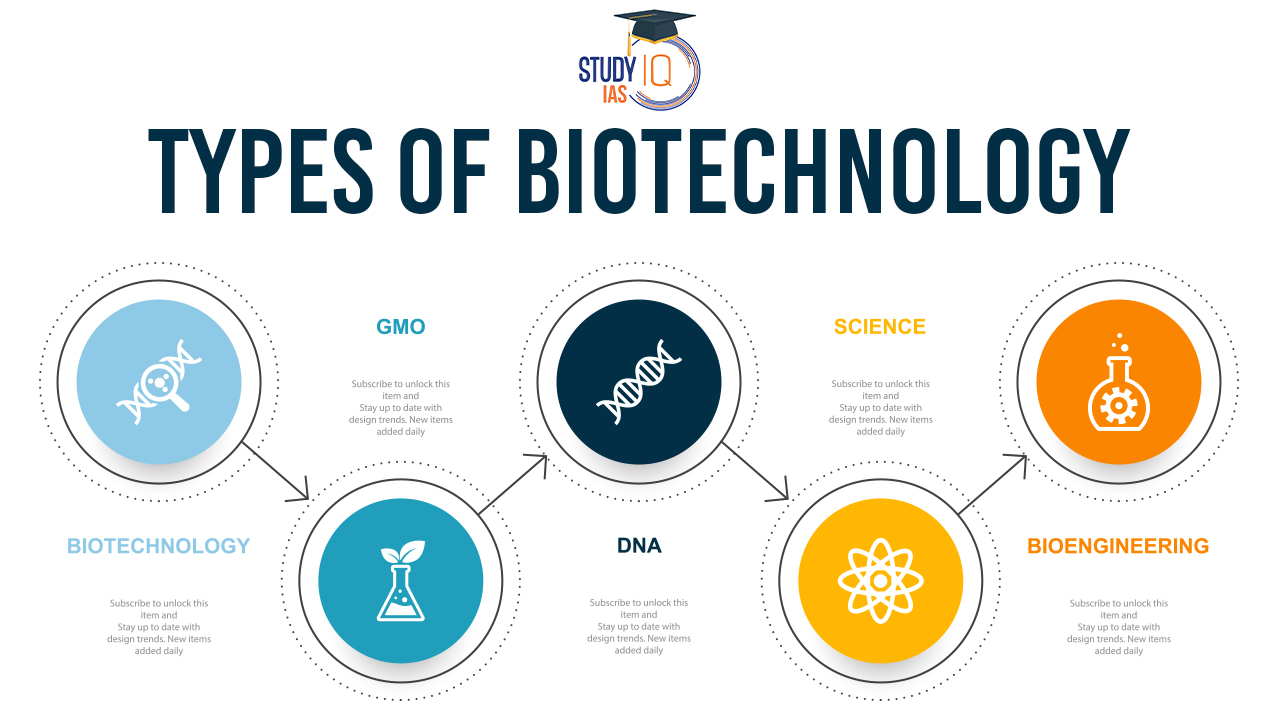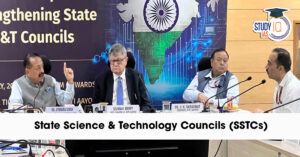Table of Contents
Biotechnology is a multidisciplinary field that utilizes biological systems, organisms, or their derivatives to develop or create products and processes that benefit various industries, including medicine, agriculture, environmental science, and more. There are several types of biotechnology, each with its own focus and applications.
Types of Biotechnology
Biotechnology, a vital branch of biology, employs genetic engineering and sterile environments to harness microorganisms, plant and animal cells, and their components to create products and processes benefiting humanity. It revolves around the development of recombinant DNA, cloning desired genes, and their transfer into suitable host organisms.
Diverse subfields include medical biotechnology, agricultural biotechnology, blue biotechnology for marine solutions, red biotechnology for healthcare, industrial biotechnology for products like enzymes and biofuels, and environmental biotechnology addressing waste management and environmental concerns. This dynamic field offers innovative solutions, from life-saving medicines to sustainable agriculture and eco-friendly industrial processes, shaping a brighter future.
We’re now on WhatsApp. Click to Join
Classification of Biotechnology in Detail
Medical Biotechnology
- Pharmaceutical Biotechnology: This involves the use of biological agents, such as proteins and genetic materials, to develop new drugs and therapies. Recombinant DNA technology is often employed to produce therapeutic proteins like insulin, growth factors, and monoclonal antibodies.
- Gene Therapy: This field focuses on the direct manipulation of an individual’s genes to treat or prevent diseases. It involves the introduction, removal, or replacement of specific genes to correct genetic disorders.
- Vaccinology: Vaccinology employs biotechnology to create vaccines that stimulate the immune system to produce protective antibodies against various diseases. Modern vaccine development often relies on genetic engineering techniques.
- Personalized Medicine: This emerging field uses genetic and molecular information to tailor medical treatments to an individual’s unique genetic makeup. It allows for more precise diagnosis and treatment, potentially reducing side effects and improving outcomes.
Agricultural Biotechnology
- Genetically Modified Organisms (GMOs): Agricultural biotechnology involves the genetic modification of plants and animals to enhance their characteristics. This can result in crops with improved resistance to pests, diseases, and environmental conditions or livestock with enhanced growth and productivity.
- Crop Improvement: Biotechnology is used to develop new plant varieties through techniques like selective breeding, tissue culture, and genetic engineering. These methods aim to create more resilient and productive crops.
- Biological Pest Control: Biotechnology can also be employed to develop biological control agents, such as genetically modified insects, to combat pests and reduce the need for chemical pesticides.
Environmental Biotechnology
- Bioremediation: This involves the use of microorganisms and enzymes to clean up pollutants and contaminants in the environment, such as oil spills, industrial waste, and heavy metals.
- Wastewater Treatment: Biotechnology is applied to improve the efficiency of wastewater treatment processes, including the removal of organic matter, nutrients, and harmful microorganisms.
- Bioenergy Production: Microorganisms and plants can be used to produce biofuels like ethanol and biodiesel, offering more sustainable alternatives to fossil fuels.
Industrial Biotechnology
- Fermentation Processes: Microorganisms are used to produce various products through fermentation, including antibiotics, enzymes, and food additives.
- Enzyme Technology: Enzymes are employed in various industrial processes to catalyze chemical reactions, making them more efficient and eco-friendly.
- Biopolymers: Biotechnology is used to produce biodegradable polymers from renewable resources, reducing the environmental impact of plastics and other synthetic materials.
Biomedical Engineering
- Tissue Engineering: This field combines biology and engineering to create artificial tissues and organs for transplantation or research. It holds promise for regenerative medicine.
- Biomechanics: Biomedical engineers apply principles of mechanics to understand how the human body works and to develop medical devices like artificial limbs, joint replacements, and heart valves.
Food Biotechnology
- Food Fermentation: Microorganisms are used to ferment foods and beverages like yogurt, cheese, and beer, enhancing flavor and shelf life.
- Genetically Modified Foods: Biotechnology is employed to develop crops with improved nutritional content, longer shelf life, and resistance to pests and environmental stressors.
Forensic Biotechnology
- DNA Fingerprinting: Genetic techniques are used in forensic science to identify individuals, solve crimes, and establish paternity.
- Forensic Pathology: Biotechnology aids in the examination of tissue samples and identification of cause of death.
Environmental Biotechnology
- Bioremediation: This involves the use of microorganisms and enzymes to clean up pollutants and contaminants in the environment, such as oil spills, industrial waste, and heavy metals.
- Wastewater Treatment: Biotechnology is applied to improve the efficiency of wastewater treatment processes, including the removal of organic matter, nutrients, and harmful microorganisms.
- Bioenergy Production: Microorganisms and plants can be used to produce biofuels like ethanol and biodiesel, offering more sustainable alternatives to fossil fuels.
Industrial Biotechnology
- Fermentation Processes: Microorganisms are used to produce various products through fermentation, including antibiotics, enzymes, and food additives.
- Enzyme Technology: Enzymes are employed in various industrial processes to catalyze chemical reactions, making them more efficient and eco-friendly.
- Biopolymers: Biotechnology is used to produce biodegradable polymers from renewable resources, reducing the environmental impact of plastics and other synthetic materials.
Biomedical Engineering
- Tissue Engineering: This field combines biology and engineering to create artificial tissues and organs for transplantation or research. It holds promise for regenerative medicine.
- Biomechanics: Biomedical engineers apply principles of mechanics to understand how the human body works and to develop medical devices like artificial limbs, joint replacements, and heart valves.
Food Biotechnology
- Food Fermentation: Microorganisms are used to ferment foods and beverages like yogurt, cheese, and beer, enhancing flavor and shelf life.
- Genetically Modified Foods: Biotechnology is employed to develop crops with improved nutritional content, longer shelf life, and resistance to pests and environmental stressors.
Forensic Biotechnology
- DNA Fingerprinting: Genetic techniques are used in forensic science to identify individuals, solve crimes, and establish paternity.
- Forensic Pathology: Biotechnology aids in the examination of tissue samples and identification of cause of death.
Neuro Biotechnology
- Neuropharmacology: Focuses on the development of drugs and therapies for neurological disorders and the study of the brain’s function.
- Neuroengineering: Involves the integration of biology and engineering to create devices for brain-machine interfaces, such as neural prosthetics and brain-computer interfaces.
Nano Biotechnology
- Nanomedicine: Utilizes nanoscale materials for drug delivery, imaging, and diagnostics. It allows for targeted and more effective medical treatments.
- Nanobiomaterials: Nanostructures are used in the design of biocompatible materials for various biomedical applications, including tissue regeneration and drug delivery.
Stem Cell Research
- Regenerative Medicine: Focuses on using stem cells to repair or replace damaged or diseased tissues and organs. It has potential applications in treating conditions like spinal cord injuries, heart disease, and diabetes.
Check here: Biotech Regulatory Agencies in India
Type of Biotechnology and Their Applications
| Type of Biotechnology | Description and Applications |
| Medical Biotechnology |
|
| Agricultural Biotechnology |
|
| Environmental Biotechnology |
|
| Industrial Biotechnology |
|
| Biomedical Engineering |
|
| Food Biotechnology |
|
| Forensic Biotechnology |
|
| Neurobiotechnology |
|
| NanoBiotechnology |
|
| Stem Cell Research |
|
Check here: DeepFake Technology
Types of Biotechnology UPSC
Biotechnology, a multifaceted field, employs genetic engineering and sterile environments to harness biological systems for diverse applications. It includes medical biotechnology for pharmaceuticals and gene therapy, agricultural biotechnology enhancing crops and pest control, environmental biotechnology for pollution cleanup and bioenergy, and industrial biotechnology producing products through fermentation and enzymes. Biomedical engineering focuses on artificial tissues and biomechanical devices.
Food biotechnology involves fermentation and genetically modified crops. Forensic biotechnology aids in crime-solving through DNA fingerprinting. Neurobiotechnology explores neurological drugs and interfaces, while nanobiotechnology uses nanomaterials for drug delivery. Stem cell research centres on regenerative medicine and tissue replacement.


 State Science and Technology Councils (S...
State Science and Technology Councils (S...
 Astronomers Discover Third Interstellar ...
Astronomers Discover Third Interstellar ...
 DRDO and Air Force Successfully Test Ind...
DRDO and Air Force Successfully Test Ind...





















